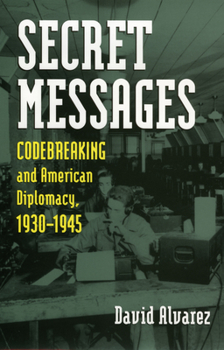Secret Messages: Codebreaking and American Diplomacy, 1930-1945
To defeat your enemies you must know them well. In wartime, however, enemy codemakers make that task much more difficult. If you cannot break their codes and read their messages, you may discover too... This description may be from another edition of this product.
Format:Hardcover
Language:English
ISBN:0700610138
ISBN13:9780700610136
Release Date:April 2000
Publisher:University Press of Kansas
Length:302 Pages
Weight:1.43 lbs.
Dimensions:1.1" x 6.4" x 9.3"
Customer Reviews
2 ratings
Secret Messages Makes Existing Works on Subject Obsolete
Published by Thriftbooks.com User , 21 years ago
Secret Messages is a meticulously researched, carefully reasoned, and well-written account of the United States government's attack on the diplomatic communications of foreign governments from 1930 to 1945, an attack that produced the most valuable secret intelligence on foreign relations and national security that the United States possessed during this period. Secret Messages is one of the first works to make extensive use of the Historic Cryptographic Collection (HCC), an enormous collection of nearly 1500 boxes of documents relating to United States cryptography and cryptanalysis before 1945 that was deposited into the United States National Archives by the National Security Agency in 1996. The importance of this collection to the history of United States code- and cipher-breaking before 1945 is ably demonstrated by Professor Alvarez, and makes very clear that works on United States cryptanalytic intelligence, foreign policy, and national security policy from 1939 to 1945 that do not take account of the HCC are to a greater or lesser extent (depending on the precise topic) both insufficient and out of date.Secret Messages provides much fascinating detail on the United States's cryptanalytic attack against the diplomatic communications of foreign countries from 1930 to 1945, an effort that after Pearl Harbor became very wide-ranging indeed, and eventually seems to have included almost every country in the world in its list of targets. While the United States's main cryptanalytic effort before the end of the Second World War was directed against Japanese systems, a fact that was made known to the public shortly after the end of the war, and American collaboration with the British attack against German Enigma systems was revealed in the 1970s, details of the work on breaking into many other countries' diplomatic communications during the Second World War was regarded by the United States government as too important to United States national security (or too embarrassing) to be released until recently. Although few eyebrows would be raised at the account in Secret Messages of United States cryptanalytic efforts against the diplomatic communications of pro-Axis neutrals such as Argentina, Spain, and Sweden, more surprising is the story of the vigorous attempts to break into the official communications of more conscientious neutrals such as Switzerland and the Vatican. Most troubling of all is the material on the cryptanalytic assaults against the communications of staunch Allied governments, such as the governments-in-exile of the Free French, Dutch, and Poles. What strikes this reviewer as ironic is that this tremendous and unscrupulous effort, undertaken mostly by cryptanalysts in the army's Signal Intelligence Service (SIS) (but which also included the collaboration of FBI agents who burgled foreign embassies in search of cryptographic materials), was made with the full approval and support of Secretary of War Henry L. Stimson, the s
an informative look at a struggle behind the big struggle
Published by Thriftbooks.com User , 24 years ago
Anyone who has ever been engaged in developing an innovative activity in a highly bureaucratic organization will appreciate the information provided in this book. What to do, how to do it, how to organize the activity, how to present the information, how to share it were all issues the Army, Navy, and national leaders of the United States and England had to resolve under the most difficult of conditions. Most importantly, who gets the credit for it was always a factor. The Navy and the FBI do not come out smelling like roses in this very thorough analysis of a critical chapter in the history of WW II. This is not a book for the novice; a familarity with many of the issues discussed is required for an appreciation of the information it provides. Nor is it a James Bond thriller. It requires attention, effort and a glass or two of good wine. It is a valuable addition to our body of knowledge and is well worth reading. Communication techniques have changed dramatically since these events of fifty years ago took place and one can only marvel at how much more complicated things must be in this field today.





